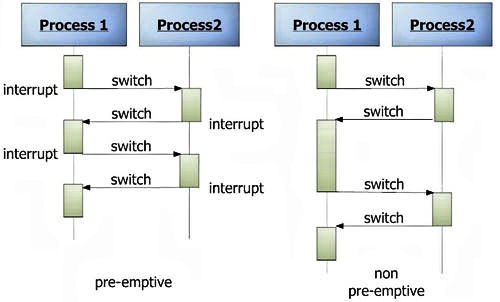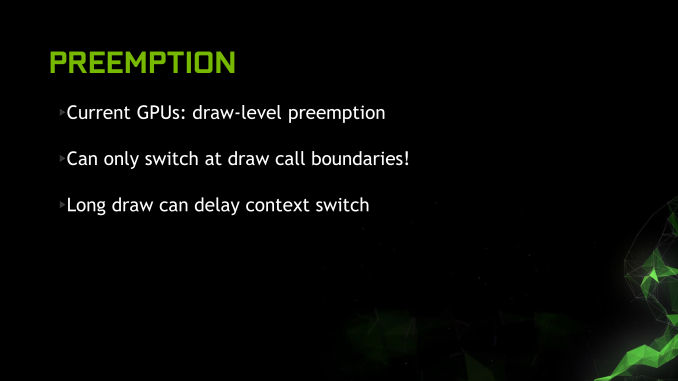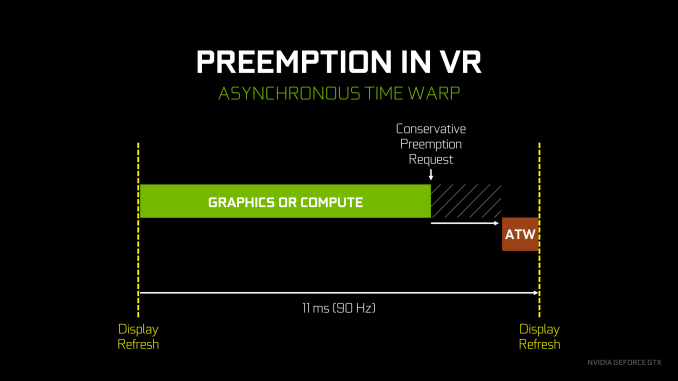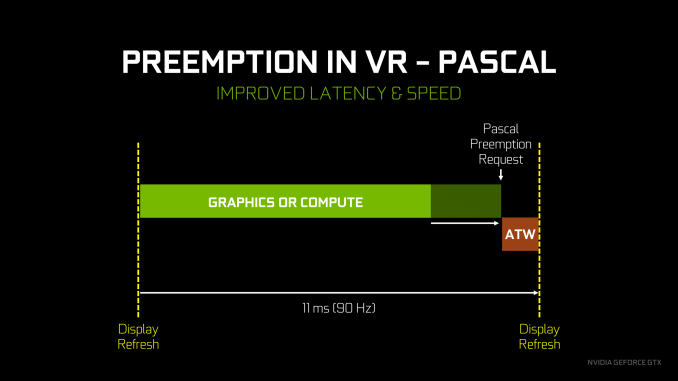The NVIDIA GeForce GTX 1080 & GTX 1070 Founders Editions Review: Kicking Off the FinFET Generation
by Ryan Smith on July 20, 2016 8:45 AM ESTPreemption Improved: Fine-Grained Preemption for Time-Critical Tasks
Continuing our discussion thus far on asynchronous compute and concurrency, the Pascal architecture includes another major feature update related to how work is scheduled. For those of you who have caught our earlier coverage of NVIDIA’s Pascal P100 accelerator, then you should already have an idea of what this is, as NVIDIA touted it as an HPC feature as well. I am of course speaking about fine-grained preemption.
Before we start, in writing this article I spent some time mulling over how to best approach the subject of fine-grained preemption, and ultimately I’m choosing to pursue it on its own page, and not on the same page as concurrency. Why? Well although it is an async compute feature – and it’s a good way to get time-critical independent tasks started right away – its purpose isn’t to improve concurrency.
Asynchronous compute is in a sense a catch-all term, as the asynchronous execution of tasks has a number of different uses. But for consumer products, it’s important to make a distinction between those features that improve concurrency and allow a GPU to get more work done – which is the best understood feature of asynchronous compute – and other features that make more novel use of async. Fine-grained preemption is distinctly in the latter category.
So what is preemption then? In a nutshell, it’s the ability to interrupt an active task (context switch) on a processor and replace it with another task, with the further ability to later resume where you left off. Historically this is a concept that’s more important for CPUs than GPUs, especially back in the age of single core CPUs, as preemption was part of how single core CPUs managed to multitask in a responsive manner. GPUs, for their part, have supported context switching and basic preemption as well for quite some time, however until the last few years it has not been a priority, as GPUs are meant to maximize throughput in part by rarely switching tasks.

(Robert Berger/EE Times: Getting real (time) about embedded GNU/Linux)
Preemption in turn is defined by granularity; how quickly a processor can actually context switch. This ranges from coarse grained-context switching, which is essentially only being able to context switch at certain points in execution, out to fine-grained context switching that allows for an almost immediate switch at any point in time. What’s new for Pascal then is that preemptive context switching just got a lot finer grained, especially for compute.
Diving deeper, to understand what NVIDIA has done, let’s talk about prior generation architectures. Previously, with Maxwell 2 and older architectures, NVIDIA only offered very coarse grained preemption. For graphics tasks or mixed graphics/compute tasks, NVIDIA could only preempt at the boundary of draw calls – collections of triangles and other draw commands, potentially encompassing dozens of polygons and hundreds (if not thousands) of pixels and threads.
The great thing about preempting at a draw call boundary is that it’s relatively clean, as draw calls are a very large and isolated unit of work. The problem with preempting at a draw call boundary is that draw calls are a very large unit of work; just because you call for the preemption doesn’t mean you’re going to get it any time soon. This analogy extends over to the compute side as well, as whole blocks of threads needed to be completed before a preemption could take place.
In fact it’s probably the compute side that’s a better real-world example of the problem with coarse-grained preemption. If you’ve ever run a GPU compute program and had your display driver reboot due to Timeout Detection and Recovery (TDR), then you’ve experienced coarse-grained preemption. For end-user responsiveness and quality purposes, Windows will reset a GPU if it doesn’t respond for more than around 2 seconds. With coarse-grained preemption, it is possible to schedule a compute task that takes so long to run that a block can’t complete in time for the Windows check-in, triggering the TDR reset. Consequently, there is good reason to support finer grained preemption for both graphics and compute tasks.
This in turn is where Pascal steps in. Along with the aforementioned improvements to how Pascal can fill up its execution pipelines, Pascal also implements a radically improved preemption ability. Depending on whether it’s a graphics or a pure compute task, Pascal can now preempt at the thread level or even the instruction level respectively.
Starting with the case of a graphics task or a mixed graphics + compute task, Pascal can now interrupt at the thread level. For a compute workload this is fairly self-explanatory. Meanwhile for a graphics workload the idea is very similar. Though we’re accustomed to working with pixels as the fundamental unit in a graphics workload, under the hood the pixel is just another thread. As a result the ability to preempt at a thread has very similar consequences for both a graphics workload and the compute threads mixed in with a graphics workload.
With Maxwell 2 and earlier architectures, the GPU would need to complete the whole draw call before preempting. However now with Pascal it can preempt at the pixel level within a triangle, within a draw call. When a preemption request is received, Pascal will stop rasterizing new pixels, let the currently rastered pixels finish going through the CUDA cores, and finally initiate the context switch once the above is done. NVIDIA likes to call this “Pixel Level Preemption.”
In terms of absolute time the benefit of course varies from game to game, and also a bit of luck depending on where in the draw call you are when the preemption request is made. But in general, draw call size and complexity has been going up over the years due to a combination of CPU limits (draw calls are expensive under DX11/OpenGL, which is why we have DX12/Vulkan) and the fact that pixel shaders continue to get longer, consequently taking more time for a given pixel/thread to fully execute. But in the end, the result is that Pascal can now execute a preemptive context switch for graphics much more rapidly than Maxwell 2 could.
Meanwhile in a pure compute scenario (i.e. running a CUDA program) Pascal takes things one step further. Not satisfied with preempting at the thread level, Pascal can actually preempt at the lowest level of them all, the instruction level. This means preempting a thread mid-flow, before the next instruction begins. The thread doesn’t even need to reach completion; with instruction level preemption, the thread can be pulled virtually immediately, Vaudeville Hook style.
This kind of fine-grained preemption is the most powerful, but it’s also primarily on the GPU for compute purposes. The greatest significance to consumers is allowing CUDA compute applications to run without triggering the TDR watchdog, as now they can stop on the spot and let the watchdog complete its work. This, not-so-coincidentally, has been one of Microsoft’s long-term goals with WDDM development, as they’ve been pushing GPU vendors to support finer-grained preemption for this very reason. Though more broadly speaking, NVIDIA’s plans are greater than just WDDM and the TDR watchdog, such as allowing functionality like interactive debugging of CUDA programs on a single-GPU system (previously they were greater limitations and you’d often need multiple GPUs).
The trade-off for finer-grained preemption is that the deeper you go – the more “in the middle of things” you allow the interruption – the more work it is to context switch. Preempting at the draw call level involves very little state information, preempting at the thread level involves a fair bit of state, and preempting at the instruction level involves a massive amount of state, including the full contents of the L1 caches and the register files. In the case of the latter you’re looking at a minimum of several megabytes of state information that have to be recorded and sent to VRAM for storage. So finer-grained preemption is a very big deal at the implementation level, requiring new hardware to load and save states quickly, and then get it off to VRAM without skipping a beat.
The actual time cost for preemption varies with the workload, but at the most basic level, when the GPU is ready to execute the context switch, NVIDIA tells us that it can be done in under 100us (0.1ms), or about 170,000 clock cycles. Relative to the GPU this is not an insignificant amount of time, and while it’s much faster than the total context switch time from Maxwell 2, it does mean that context switching is still a somewhat expensive operation (roughly 50-100x more so than on a modern Intel CPU). So context switching still needs to be used intelligently, and, for best performance, infrequently.
Meanwhile I’ll quickly note that while the current Pascal drivers only implement thread/pixel level preemption for graphics and mixed workloads, as you might suspect from Pascal’s instruction level preemption capabilities for compute, this is something of an arbitrary decision. Because instruction level preemption is a fundamental Pascal ability, it could be made to do so for graphics as well as compute. The reason why NVIDIA has gone this route is one of cost/benefit tradeoffs; the DirectX team doesn’t believe that preemption at this level is necessary for graphics, in part because pixel shaders aren’t prone to long loops like dedicated compute kernels are, so the next thread boundary will come up relatively quickly. And preempting at the thread boundary is easier (i.e. there’s less state) than at the instruction level. This is something that NVIDIA could theoretically change course on in the future, but at least for now the belief is that the need/demand for such fine-grained preemption in a graphics context isn’t there.
Finally, speaking of graphics, let’s talk about what pixel/thread level preemption is going to be used for. Overall there aren’t too many cases where you want to context switch in the middle of a graphics task, but there is one case that NVIDIA considers very important: asynchronous time warp. We’ve covered asynchronous time warp before, so I won’t fully rehash it here, but in short it’s a neat hack for VR where the frame being prepared for a headset is warped at the last possible moment, using up-to-the-millisecond positioning data, in order to give the illusion that the frame is newer than it actually is. The benefit is that it reduces the perceived input lag of VR, which is one of the causes of simulator sickness.
NVIDIA has supported async time warp since Oculus enabled the feature in their SDK, however given the above limitations of Maxwell 2, the architecture wasn’t able to execute an async time warp very efficiently. Assuming there weren’t any free SMs to work on a time warp right away, the need to wait until the end of a draw call meant that it could potentially be a relatively large amount of time until the context switch took place. This required the software stack to be relatively conservative with the preemption call, making the call early in order to ensure that the time warp could execute before it’s too late.
With Pascal’s much improved preemption capabilities, this significantly changes how conservative async time warp needs to be. Pascal’s finer-grained preemption means that the preemption request can come much later. The benefit is that this both better ensures that the async time warp actually occurs in time – there’s virtually no chance of a thread taking too long to finish – and it means that much less GPU time is wasted from the GPU idling due to the conservative preemption request. The end result is that the performance impact of async time warp is reduced on Pascal as compared to Maxwell 2, allowing the GPU to spend more time in every refresh interval doing productive work.
All of that said, I don’t have a good feel for the benefit in terms of numbers; like so many other cases it’s going to depend on the specific game in use, and for that matter how well the game is saturating the GPU given the fixed 90Hz update interval. And though this puts Maxwell 2 in a lesser light, at least so far I haven’t personally noticed Maxwell 2 struggling to execute an async time warp. That Maxwell 2 does as well as it does is likely a testament to the viability of conservative preemption requests, which is to say that it will be interesting if we ever get a chance to see just how much performance Maxwell 2 had to leave on the table to reliably execute async time warps.















200 Comments
View All Comments
grrrgrrr - Wednesday, July 20, 2016 - link
Solid review! Some nice architecture introductions.euskalzabe - Wednesday, July 20, 2016 - link
The HDR discussion of this review was super interesting, but as always, there's one key piece of information missing: WHEN are we going to see HDR monitors that take advantage of these new GPU abilities?I myself am stuck at 1080p IPS because more resolution doesn't entice me, and there's nothing better than IPS. I'm waiting for HDR to buy my next monitor, but being 5 years old my Dell ST2220T is getting long in the teeth...
ajlueke - Wednesday, July 20, 2016 - link
Thanks for the review Ryan,I think the results are quite interesting, and the games chosen really help show the advantages and limitations of the different architectures. When you compare the GTX 1080 to its price predecessor, the 980 Ti, you are getting an almost universal ~25%-30% increase in performance.
Against rival AMDs R9 Fury X, there is more of a mixed bag. As the resolutions increase the bandwidth provided by the HBM memory on the Fury X really narrows the gap, sometimes trimming the margin to less that 10%,s specifically in games optimized more for DX12 "Hitman, "AotS". But it other games, specifically "Rise of the Tomb Raider" which boasts extremely high res textures, the 4Gb memory size on the Fury X starts to limit its performance in a big way. On average, there is again a ~25%-30% performance increase with much higher game to game variability.
This data lets a little bit of air out of the argument I hear a lot that AMD makes more "future proof" cards. While many Nvidia 900 series users may have to upgrade as more and more games switch to DX12 based programming. AMD Fury users will be in the same boat as those same games come with higher and higher res textures, due to the smaller amount of memory on board.
While Pascal still doesn't show the jump in DX12 versus DX11 that AMD's GPUs enjoy, it does at least show an increase or at least remain at parity.
So what you have is a card that wins in every single game tested, at every resolution over the price predecessors from both companies, all while consuming less power. That is a win pretty much any way you slice it. But there are elements of Nvidia’s strategy and the card I personally find disappointing.
I understand Nvidia wants to keep features specific to the higher margin professional cards, but avoiding HBM2 altogether in the consumer space seems to be a missed opportunity. I am a huge fan of the mini ITX gaming machines. And the Fury Nano, at the $450 price point is a great card. With an NVMe motherboard and NAS storage the need for drive bays in the case is eliminated, the Fury Nano at only 6” leads to some great forward thinking, and tiny designs. I was hoping to see an explosion of cases that cut out the need for supporting 10-11” cards and tons of drive bays if both Nvidia and AMD put out GPUs in the Nano space, but it seems not to be. HBM2 seems destined to remain on professional cards, as Nvidia won’t take the risk of adding it to a consumer Titan or GTX 1080 Ti card and potentially again cannibalize the higher margin professional card market. Now case makers don’t really have the same incentive to build smaller cases if the Fury Nano will still be the only card at that size. It’s just unfortunate that it had to happen because NVidia decided HBM2 was something they could slap on a pro card and sell for thousands extra.
But also what is also disappointing about Pascal stems from the GTX 1080 vs GTX 1070 data Ryan has shown. The GTX 1070 drops off far more than one would expect based off CUDA core numbers as the resolution increases. The GDDR5 memory versus the GDDR5X is probably at fault here, leading me to believe that Pascal can gain even further if the memory bandwidth is increased more, again with HBM2. So not only does the card limit you to the current mini-ITX monstrosities (I’m looking at you bulldog) by avoiding HBM2, it also very likely is costing us performance.
Now for the rank speculation. The data does present some interesting scenarios for the future. With the Fury X able to approach the GTX 1080 at high resolutions, most specifically in DX12 optimized games. It seems extremely likely that the Vega GPU will be able to surpass the GTX 1080, especially if the greatest limitation (4 Gb HBM) is removed with the supposed 8Gb of HBM2 and games move more and more the DX12. I imagine when it launches it will be the 4K card to get, as the Fury X already acquits itself very well there. For me personally, I will have to wait for the Vega Nano to realize my Mini-ITX dreams, unless of course, AMD doesn’t make another Nano edition card and the dream is dead. A possibility I dare not think about.
eddman - Wednesday, July 20, 2016 - link
The gap getting narrower at higher resolutions probably has more to do with chips' designs rather than bandwidth. After all, Fury is the big GCN chip optimized for high resolutions. Even though GP104 does well, it's still the middle Pascal chip.P.S. Please separate the paragraphs. It's a pain, reading your comment.
Eidigean - Wednesday, July 20, 2016 - link
The GTX 1070 is really just a way for Nvidia to sell GP104's that didn't pass all of their tests. Don't expect them to put expensive memory on a card where they're only looking to make their money back. Keeping the card cost down, hoping it sells, is more important to them.If there's a defect anywhere within one of the GPC's, the entire GPC is disabled and the chip is sold at a discount instead of being thrown out. I would not buy a 1070 which is really just a crippled 1080.
I'll be buying a 1080 for my 2560x1600 desktop, and an EVGA 1060 for my Mini-ITX build; which has a limited power supply.
mikael.skytter - Wednesday, July 20, 2016 - link
Thanks Ryan! Much appreciated.chrisp_6@yahoo.com - Wednesday, July 20, 2016 - link
Very good review. One minor comment to the article writers - do a final check on grammer - granted we are technical folks, but it was noticeable especially on the final words page.madwolfa - Wednesday, July 20, 2016 - link
It's "grammar", though. :)Eden-K121D - Thursday, July 21, 2016 - link
Oh the ironychrisp_6@yahoo.com - Thursday, July 21, 2016 - link
oh snap, that is some funny stuff right there